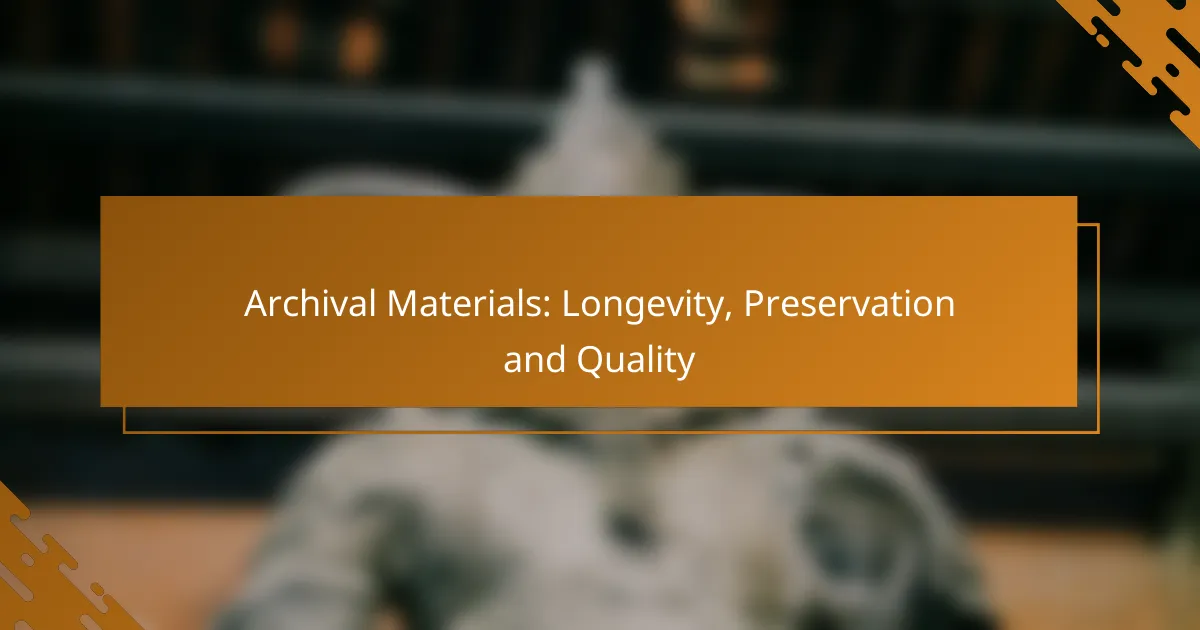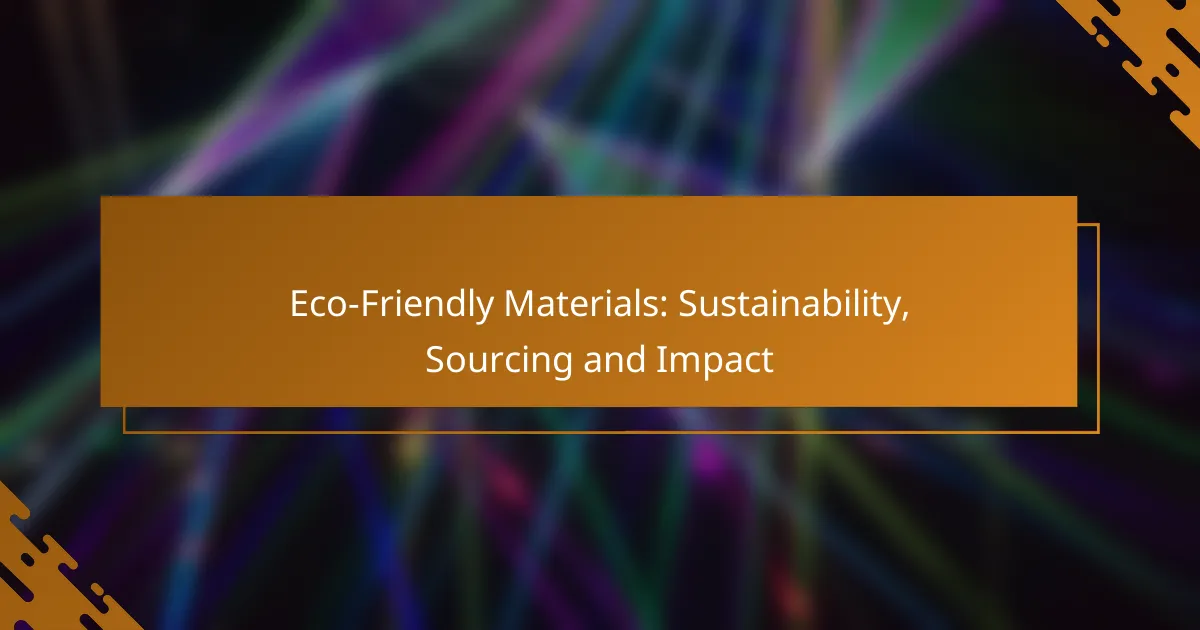Archival materials are essential for ensuring the longevity and preservation of documents and artifacts, designed to resist deterioration over time. Utilizing options such as acid-free paper and Mylar sleeves, along with maintaining optimal environmental conditions, is crucial for safeguarding these valuable items. The quality of archival materials is determined by their composition, manufacturing standards, and testing certifications, which collectively influence their durability and integrity.

What are the best archival materials for longevity?
The best archival materials for longevity are designed to resist deterioration and maintain the integrity of documents and artifacts over time. Key options include acid-free paper, Mylar sleeves, archival boxes, photographic films, and polyester films, each serving specific preservation needs.
Acid-free paper
Acid-free paper is essential for preserving documents, as it prevents yellowing and degradation caused by acidic content. Look for papers that meet the ANSI/ISO 9706 standard for permanence, which ensures they are free from harmful chemicals.
When selecting acid-free paper, consider its weight and texture, as these factors can affect print quality and durability. A weight of 20-24 lb is common for standard documents, while heavier options are available for archival purposes.
Mylar sleeves
Mylar sleeves provide a protective barrier for photographs, documents, and other fragile items, shielding them from dust, moisture, and physical damage. These sleeves are made from a polyester film that is both strong and transparent, allowing for easy viewing.
When using Mylar sleeves, ensure they are of archival quality, as lower-grade options may contain additives that can harm the contents over time. Consider using sleeves with a thickness of 2-4 mil for optimal protection.
Archival boxes
Archival boxes are designed to store documents and artifacts safely, preventing exposure to light, dust, and environmental fluctuations. Look for boxes made from acid-free materials and that comply with preservation standards.
Choose the right size for your items, as boxes that are too tight can cause damage, while those that are too loose may allow movement and exposure. Consider using boxes with a lid to provide additional protection against light and dust.
Photographic films
Photographic films, particularly those made from archival-quality materials, are crucial for preserving images over long periods. These films are designed to resist fading and deterioration, ensuring that photographs maintain their quality.
When selecting photographic films, consider options that are rated for longevity, such as those with a lifespan of several decades when stored properly. Store films in a cool, dry environment to maximize their lifespan.
Polyester films
Polyester films are another excellent choice for archival preservation, offering high clarity and durability. These films are often used for encapsulating documents and photographs, providing a protective layer without compromising visibility.
When using polyester films, ensure they are free from harmful additives and are of archival quality. A thickness of 3 mil or more is recommended for enhanced protection against wear and tear.

How to preserve archival materials effectively?
To preserve archival materials effectively, maintain optimal environmental conditions and handle items with care. Key factors include controlling temperature, managing humidity, and reducing light exposure to prolong the lifespan of these valuable documents.
Temperature control
Maintaining a stable temperature is crucial for the preservation of archival materials. Ideally, temperatures should be kept between 18°C and 22°C (64°F to 72°F) to minimize deterioration. Fluctuations can cause expansion and contraction, leading to damage.
Use thermostats and temperature loggers to monitor conditions regularly. Avoid placing materials near heat sources, such as radiators or direct sunlight, as these can raise temperatures unexpectedly and harm the integrity of the items.
Humidity management
Humidity levels significantly impact the preservation of archival materials. Aim for a relative humidity of 30% to 50% to prevent mold growth and material degradation. High humidity can lead to mold, while low humidity can cause brittleness.
Utilize dehumidifiers or humidifiers as needed to maintain consistent levels. Regularly check humidity with hygrometers, and consider using silica gel packets in storage areas to absorb excess moisture.
Light exposure reduction
Reducing light exposure is essential for protecting archival materials from fading and deterioration. Ultraviolet (UV) light is particularly damaging, so limit exposure by using UV-filtering glass in display cases and keeping items in dark storage when not in use.
When displaying materials, use low-level lighting and limit the duration of exposure. Consider rotating displays to minimize the time any single item is exposed to light, ensuring that archival materials remain in optimal condition for years to come.

What are the key factors in archival quality?
The key factors in archival quality include material composition, manufacturing standards, and testing certifications. These elements collectively determine how well archival materials can withstand the test of time and maintain their integrity.
Material composition
Material composition refers to the types of substances used in archival materials, such as paper, plastics, and inks. High-quality archival materials typically use acid-free paper and archival-grade plastics that resist degradation over time. Choosing materials that are free from harmful chemicals enhances longevity and prevents deterioration.
For example, cotton or linen paper is often preferred for its durability, while polyester is a common choice for protective enclosures. It’s essential to verify that the materials meet archival standards to ensure they do not emit harmful substances that could damage stored items.
Manufacturing standards
Manufacturing standards dictate the processes and quality controls applied during the production of archival materials. Adhering to recognized standards, such as ISO 9706 for permanent paper, ensures that materials are produced with longevity in mind. These standards often specify criteria for pH levels, lignin content, and other factors that affect durability.
When selecting archival products, look for certifications that indicate compliance with these standards. Products labeled as “archival” should ideally meet or exceed these manufacturing benchmarks to guarantee their effectiveness in preservation.
Testing certifications
Testing certifications provide assurance that archival materials have been rigorously evaluated for their performance and longevity. Various organizations conduct tests to assess factors like lightfastness, chemical stability, and physical durability. Certifications from reputable bodies, such as the American National Standards Institute (ANSI) or the International Organization for Standardization (ISO), signify that materials have undergone thorough testing.
When purchasing archival supplies, check for these certifications on product labels or descriptions. This can help you avoid materials that may not perform as expected, ensuring that your archival efforts are well-supported by quality products.

What are the costs associated with archival materials?
The costs associated with archival materials can vary significantly based on the type of materials and methods used for preservation. Key expenses include purchasing acid-free paper, storage solutions, and various preservation supplies, all of which are essential for maintaining the longevity and quality of archival items.
Price range of acid-free paper
Acid-free paper is crucial for preserving documents and photographs, as it prevents deterioration over time. Prices for acid-free paper typically range from around $10 to $50 per ream, depending on the quality and brand. Higher-end options may offer additional features such as lignin-free or buffered paper, which can further enhance preservation.
Cost of archival storage solutions
Archival storage solutions include boxes, folders, and containers designed to protect materials from environmental damage. The cost of these solutions can vary widely, with basic boxes starting at approximately $5, while specialized archival boxes can range from $20 to $100 or more. Investing in proper storage is essential to prevent physical damage and degradation.
Budgeting for preservation supplies
When budgeting for preservation supplies, consider items such as archival tape, photo corners, and humidity control packs. A reasonable budget for these supplies might range from $50 to $200 annually, depending on the volume of materials being preserved. Prioritize high-quality products to ensure the best protection for your archival items.

What are the best practices for archival storage?
Best practices for archival storage focus on maintaining the integrity and longevity of materials through controlled environments and careful handling. Proper techniques ensure that documents, photographs, and other items are preserved for future generations.
Using climate-controlled environments
Climate-controlled environments are essential for preserving archival materials, as they help regulate temperature and humidity levels. Ideally, storage areas should maintain a temperature between 18-20°C (64-68°F) and relative humidity around 30-50%. These conditions minimize the risk of mold, fading, and deterioration.
When setting up a climate-controlled space, consider using dehumidifiers and air conditioning systems to maintain consistent conditions. Regular monitoring with hygrometers and thermometers is crucial to ensure that these parameters are upheld. Avoid placing materials near windows or heat sources to prevent fluctuations.
Additionally, implementing a backup power system can protect against sudden outages that could disrupt climate control. This precaution is particularly important in regions with extreme weather conditions, where temperature and humidity can vary significantly.

